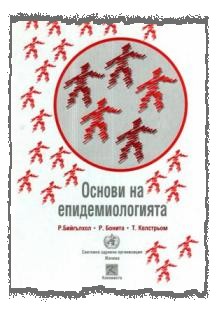
BASIC EPIDEMIOLOGY
Authors: R. Beaglehole and R. Bonita; translated by Gena Gruntcharova
Editor's Note: The concentration of epidemiology in Bulgaria is exemplified by TEMPUS JEP-3604, named "Support for Public Health Disciplines" and with co-ordinators: Prof. John Powles from Cambridge University, UK and Prof. Ivan Chernozemsky, National Oncology Center, Bulgaria. During the period 1992-1995, considerable effort was focused on modern epidemiology education and partnership with Western European institutions developed - Cambridge, Rotterdam, Edinburgh, Bilbao, etc. Further, in compliance with TEMPUS JEN for years 1994-1997, a cycle of seminars were held for four consecutive years at Golden Sands, Bulgaria. The aim of the seminars was to train young epidemiologists and incorporate their knowledge in health policy reform.
This is book from the TEMPUS JEP-3604 syllabus. It is a bulgarian translation from the highly successful manual of WHO, ditto*.

A textbook providing a basic introduction to the principles, methods, and applications of epidemiology in medicine and public health. Intended for use in a formal training course, the book aims to prepare students for an approach to health care that is increasingly concerned with preventive medicine and the most efficient use of resources. To this end, the authors use numerous examples from the scientific literature to show how the tools of epidemiology can be applied to the prevention of disease, the promotion of health, and the formulation of rational policies. Particular attention is given to the use of epidemiological research to detect associations between modifiable environmental factors and specific disease.
The book has eleven chapters. The first two chapters describe the history and scope of epidemiology, highlight some of its major triumphs, and discuss various approaches to the measurement of disease. The third chapter, devoted to the different types of epidemiological study, describes the applications, advantages, and limitations of the major types of observational and experimental studies, emphasizing the many possibilities for errors in epidemiological measurement. Chapter four gives a brief account of some basic statistical concepts and techniques. Chapter five and six describe the epidemiological approach to causation and explain when and how epidemiology can be used in preventive medicine, including the design of screening programmes. A chapter on communicable disease epidemiology describes the detailed and systematic epidemiological work needed to investigate an epidemic, identify its cause, and determine the best means to control it.
Others chapters explain the application of epidemiological principles and methods to the practice of clinical medicine, and discuss the special features of environmental and occupational epidemiology, including techniques for risk assessment and risk management, and methods for determining dose-effect and dose-response relationships. Of particular practical value is a chapter on health services and health policy, which shows how epidemiology can be used to support policy choices based on a reasonable knowledge of the likely outcomes and costs. The concluding chapter offers advice on how to read the medical and health literature critically, so as to be able to make independent judgements of the reliability of epidemiological data.
"… Covering the scope of theoretical and applied epidemiology in a brief book is a daunting task, which this World Health Organization manual manages commendably …" - from British Medical Journal
"… An epidemiology textbook should be easy to read, contain sufficient information, encourage the reader to continue his or her study of epidemiology, and serve as a reference book. Basic Epidemiology meets all these requirements and more …" - from Journal of the Swedish Medical Association
"… Well written and covers all applications of epidemiology to health. Because of its wide scope and clear presentation, it would be useful as an introductory text for medical, nursing and paramedical students …" - from Epidemiology Monitor
"… Refreshingly different, with a new style and approach to teaching and learning epidemiology which is strongly recommended …" - from Indian Journal of Medical Research
Addendum: Our search in the WHOLIS database /i.e., presumably, this is the biggest Internet Library with free on-line access/, has found two titles corresponding to the referred book from above. The first is the textbook itself. The second is a Teacher's Guide, which is not translated in bulgarian and is meant to supplement the english language edition with examples and exercises. You can find these materials at the following links:
http://whqlibdoc.who.int/publications/9241544465.pdf
http://whqlibdoc.who.int/hq/1994/WHO_EHG_94.10.pdf
Copyright © 2005 by the author.